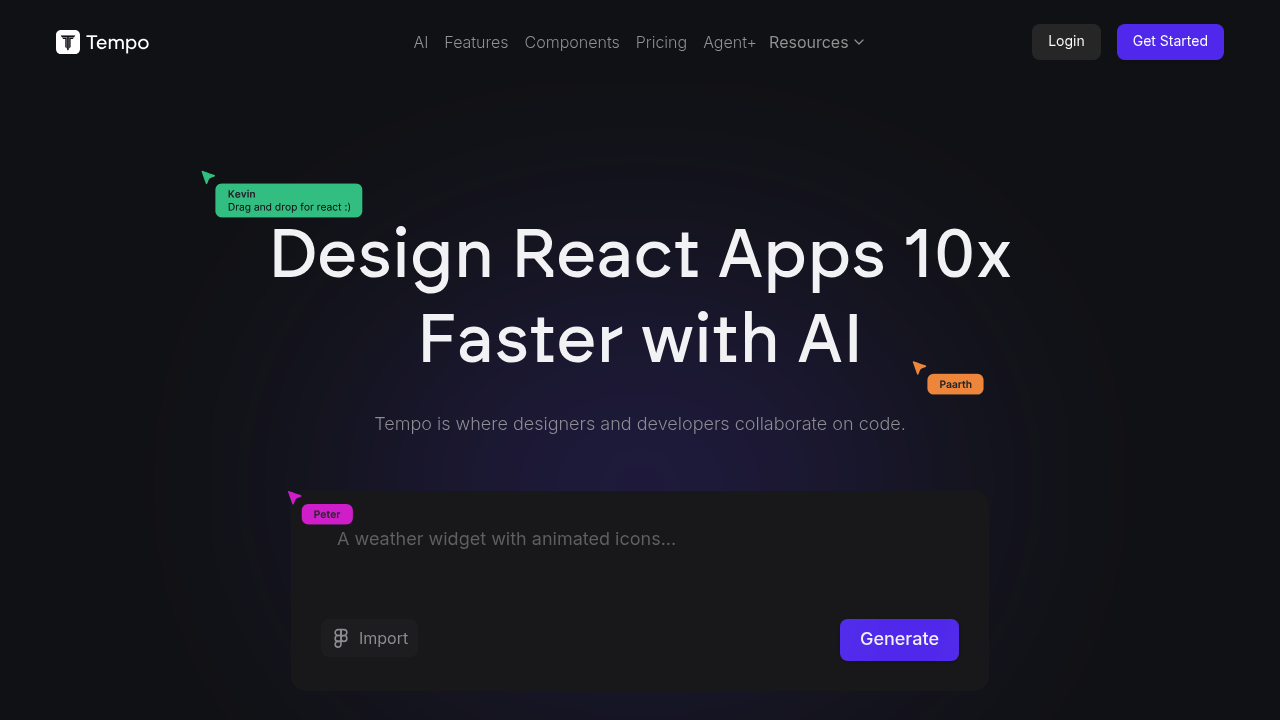Vibe Coding Tools
Vibe Coding is what all the cool kids are doing. Create full apps, tools, websites and mobile apps just chatting. NO CODING KNOWLEDGE required. Discover the best no code vibe-coding tools here.

Tempo | Prompt. Develop. Design. Collaborate.
Discover AI-powered tools at Tempo to prompt, develop, and design code effortlessly. Collaborate seamlessly with advanced solutions for faster, smarter web development.

tempo.new: The Visual IDE That Bridges The Vibe Gap
TL;DR: Tempo is an AI-powered visual IDE built for vibe coders who want the speed of a low-code design tool but need the flexibility and control of clean, production-ready React code. It dramatically cuts down on frontend boilerplate and design-to-code friction, making it a powerful co-pilot for solo devs and product teams. If your biggest headache is turning a beautiful design into a maintainable codebase, Tempo is a solid, mature option that doesn't lock you in.
A New Tempo for Development
Let's be real. The friction between design and code is the ancient enemy of the modern dev. You spend hours in Figma crafting the pixel-perfect experience, only to spend three times that long writing the boilerplate React, setting up state, wrestling with Tailwind classes, and then, inevitably, dealing with the inevitable "that doesn't look quite right" feedback loop.
This is the exact, soul-crushing problem tempo.new was built to solve.
Tempo is a visual Integrated Development Environment (IDE) that feels like a next-generation design tool but outputs genuine, clean, production-ready React code. It’s the ultimate "vibe coding" tool because it translates your vibe—your visual intention, your natural language prompt, or even a design file—directly into a working application without compromising on the code quality that your engineering team demands. It's the difference between asking an intern to write a component and having a highly-skilled co-pilot instantly scaffold the whole thing, ready for you to wire up the actual logic.
The Tempo Difference: Production Code Over Prototypes
Many tools in the vibe coding space are excellent for isolated component generation or quick, throwaway prototypes. They give you a beautiful card or a hero section, but the resulting code is often brittle, difficult to integrate, or forces you into a proprietary environment. Tempo steps out of this sandbox.
Its core differentiator is the symbiotic relationship between the visual editor and the underlying React code. It lets you:
- Edit React Code Visually: You can drag-and-drop components, adjust layouts, and tweak styles using an interface that feels as intuitive as Figma or Webflow. Crucially, the code is synchronized in real-time. There's no "export" button that gives you a dump of messy HTML and CSS; you're editing the actual React code live.
- Maintain Full Code Control: Need to drop down to the terminal or open your favorite local IDE? Tempo supports full code access, allowing you to open your project in VS Code, commit directly to GitHub, and deploy anywhere. This is a game-changer. Your code isn't trapped in a walled garden.
- Go Beyond The UI: Tempo's AI assistant is trained to help across the full development lifecycle, from generating the initial Product Requirements Document (PRD) and user flow diagrams to connecting to your Supabase or Stripe backends. It’s not just about pretty buttons; it’s about a functional product.
This level of control, paired with visual speed, is what makes Tempo a more mature option than many competitors like Lovable.dev (often cited as better for non-technical users) or v0.dev (an amazing, but limited, component prototype generator). Tempo is aimed at the serious builder—the product designer who writes some code, the solo founder, or the small team looking to move at warp speed.
Practical Benefits: Ship Features, Not Just Files
- 3x Velocity Boost (Reported): Tempo's early partners, such as a team at Chorus AI, have reported that the platform "cut our front end development costs in half and increased our velocity by 3x." Less time on boilerplate means more time on the unique, value-driving parts of your application.
- Design-to-Code Friction is Eliminated: Forget spending a day translating a Figma file into a responsive layout. Tempo handles the heavy lifting, allowing designers and developers to collaborate on the same asset—the production code.
- Full Stack Scaffold: Tempo sets you up for success from the jump. It can generate a full-stack application architecture, including auth flows and database connections, using a simple text or image prompt.
- Agent-Powered Development (Enterprise): The premium tiers offer "reasoning agents" that can design and build 1-3 features per week with a guaranteed quality review by human engineers and designers. It's essentially a fractional frontend team on tap.
As one reviewer, Ihor Levchenko, put it, "A lot of time was saved by generating and editing templates from scratch... There is a great balance between when you need to do prompt-editing of the UI elements on the preview and when you need to go into the code to make custom adjustments." This perfectly encapsulates the tool's core strength: visual scaffolding with a code safety net.
Competitors & The Vibe Coding Landscape
The vibe coding arena is heating up, and it's essential to understand where Tempo sits:
| Tool | Primary Focus | Key Differentiator | Tempo's Edge |
|---|---|---|---|
| tempo.new | Visual React UI & Full App Scaffolding | Real-time visual editor on production React code. Full control via VS Code/GitHub. | Best balance of visual design control and code portability/quality. |
| Bolt.new | Rapid Prototyping in the Browser | Runs on Stackblitz WebContainers (Node in browser). Excellent Figma Import. | Stronger design-code sync and better-structured code output. |
| Lovable.dev | Non-Coder Ease of Use | Highly intuitive "select-and-edit" UI. Very low barrier to entry. | Tempo provides deeper control and is better suited for experienced devs and scaling apps. |
| Cursor | IDE-Based AI Co-pilot | Deep multi-file, contextual AI assistance within a custom IDE. | Cursor is more dev-focused, augmenting existing code. Tempo is more design/visual-workflow focused for new features. |
Tempo is a clear choice if your priority is high-quality, clean React/Next.js code that can be visually edited and seamlessly maintained in a standard developer workflow. It's for those who have a strong design sense and know the value of a clean repo.
Real-World Use Case: Launching an MVP
Imagine you're a product manager with a solid idea for a SaaS tool—say, a simplified project management dashboard.
- Vibe Prompt: You start by prompting Tempo: "Build a responsive Next.js dashboard with a dark mode, a left-hand navigation, and a main content area with three cards for 'Tasks,' 'Progress,' and 'Team Status.' Use the Stripe and Supabase integrations."
- Visual Polish: Tempo scaffolds the app. You jump into the visual editor to tweak the card layouts, adjust the typography, and select the final color palette using the drag-and-drop controls. No CSS wrestling required.
- Code Wiring: The UI is locked. Now you move to VS Code (directly linked) and focus solely on the business logic: writing the API routes and the actual data-fetching functions. You're not spending a week on the frontend; you’re focused on the product.
This workflow is what sold Eliza Vorobiev: "I love that I can use the AI chat to help me in every stage of the product development cycle, it helps with the PRD, the design and the code."
Pricing: A Model for Serious Builders
Tempo operates on a tiered subscription model, recognizing that a full-stack AI co-pilot is a premium service for serious projects.
- Free Tier: Offers limited access to the visual IDE and a set number of AI prompts per month. Perfect for getting your feet wet and testing the core velocity gains.
- Pro Tier (Typically $XX/month + Usage): Includes higher prompt limits, more robust feature sets, and better support. This is the sweet spot for solo founders and small teams launching an MVP. The pricing model generally includes a base fee plus usage-based charges for high-cost AI operations (like complex code generation).
- Enterprise / Agent+ Plan (Custom Annual Pricing): This tier is for larger teams and agencies. It unlocks the powerful Agent+ feature, offering "done-for-you" feature builds by the Tempo team, guaranteed turnaround times, and unlimited design revisions and code review improvements. This is where you leverage the human-in-the-loop service that no pure-AI tool can match.
Heads up: Pricing structures for AI tools are constantly evolving. Always check the official tempo.new website for the most current pricing, feature inclusions, and usage limits before you commit.
Frequently Asked Questions (FAQ)
| Question | Answer |
|---|---|
| What frameworks does Tempo support? | Primarily React and Next.js, with the codebase export being clean, modern JavaScript/TypeScript. |
| Am I locked into their ecosystem? | Absolutely not. This is a key feature. Your code can be pushed to GitHub and deployed wherever you choose (Netlify, Vercel, etc.). You retain ownership and control. |
| How does it handle complex state? | It scaffolds common state patterns and lets you visually connect components to basic state management. For highly complex, application-specific state logic, you'll still need to drop into the code, but the visual structure is already done. |
Final Summary: Give It a Run
Tempo is not just a shiny new toy; it's a legitimate power tool for the modern React developer. It has successfully cracked the code-ownership problem that plagues many low-code tools, offering a visual workflow that doesn't compromise on technical excellence. If you're tired of boilerplate, context-switching between your design tool and your IDE, and feel like you’re spending too much time on the "vibe" and not enough on the "ship," you owe it to your sanity to try this.
Your next app starts with a prompt, not a blank file. Take a look at the live demo and start building your first component with tempo.new today.




